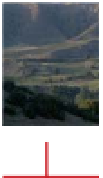Geology Reference
In-Depth Information
grains to slide past each other. In this
process, the grains will be internally
undeformed. Under higher stresses, the
grains themselves may be fractured.
Creep deformation that is dominated
by fracturing is termed
cataclastic
flow
. This process produces fabrics
characterised by angular-shaped grains
and a progressive decrease in grain
size. Alignment of elongated grains
or grain aggregates may give rise to a
shape fabric
. Frictional heating may
give rise to melted crush rock (
pseudo-
tachylite
) as described in Chapter 5.
Under higher pressure and tempera-
ture, fracturing is replaced by a process
termed
dislocation creep
, whereby
the crystals themselves are internally
deformed (e.g. by
dislocation gliding
or
twin gliding
) so as to achieve a different
shape compatible with the overall strain
(Figure 4.12B, C). Various features such
as
deformation twins
and
kink bands
characterise crystals deformed in this
way. Dislocation or twin gliding accom-
panied by rotation can orient a set of
crystals in such a way as to produce
the maximum strain effect, and leads
to a crystal orientation fabric (Figure
4.12D). These changes in crystals may
be accompanied by recrystallisation as
the strain progresses, and will be aided
by higher temperatures. Crystalline
metamorphic rocks deformed in this
way will be characterised by a
preferred
orientation
of the crystallographic
axes, since the newly shaped crystals
will tend towards an orientation such
that their crystallographic slip planes
are aligned favourably with the stress
axes. This is termed an
orientation
fabric
. Original grains may survive,
surrounded by small re-grown grains,
producing a characteristic texture.
With further increase in tempera-
ture and pressure, another mechanism
becomes dominant. Here, material is
transferred by diffusion through the
crystal lattice or along grain bounda-
ries from areas of high compressive
stress to areas of low stress either in
the solid state (
diffusion creep
) or by
solution and redeposition from a fluid
(
pressure solution
or
solution creep
)
(Figure 4.12E, F). Ultimately, complete
recrystallisation of the rock may take
place, leading generally to an increase
in grain size. This process will tend
to form a shape fabric dominated by
elongate crystal shapes that serve to
define the new strain geometry; it may
or may not produce an orientation of
the crystal axes. Solution creep is the
typical mechanism in low-grade meta-
morphic rocks where fluid is available,
whereas diffusion creep dominates
in higher-grade metamorphic rocks.
Figure 4.11 shows schematically how
these various mechanisms relate to vari-
ations in differential stress and depth
for geologically realistic strain rates.
the plate boundaries, since it is there
that the forces that act on the plates
largely originate, as explained in the
previous chapter. Although complex
and variable in detail, on a larger scale,
the principal stress orientations are
broadly at right angles to convergent
and divergent plate boundaries, and
oblique at transform faults. Within
plates, the stress orientations change
gradually from one boundary to the
other. For example, the maximum
stress orientation in western Europe,
which is largely controlled by the mid-
Atlantic ridge in the west and the Alpine
front in the south, is roughly NW-SE.
The availability of methods of accu-
rate measurement of surface position
by satellite since the 1980s has enabled
crustal movements, and therefore flow
rates, to be calculated with an accuracy
measured in millimetres. Using GPS and
InSar
(
Interferometric Short-Aperture
Radar
) measurements repeated over
time periods of years, displacement
rates on faults (
see
Chapter 5) and flow
rates in salt and ice (
see
Chapter 9)
have been deduced. These give average
velocities of several centimetres per
year in the case of faults and several
millimetres
per day
in the case of salt.
Flow rates for the Tibetan crust
resulting from the India-Asia plate col-
lision are in the range 5-15 mm/yr (
see
Chapter 11); these can be used to give
an estimate for bulk crustal shortening
strain rate of about 10
-15
(i.e. a short-
ening of one hundred trillionth!) per
second. Taking an estimated shortening
of Tibetan crust of ~50% since collision
~50 Ma ago gives the same approxima-
tion for strain rate over that period.
4
30
31
Measurement of present-day crustal
stress, strain and strain rate
There are a number of ways of measur-
ing present-day stress in the crust. For
example, the analysis of earthquake
fault plane solutions
can yield the
stress orientation (
see
Chapter 5) and
the use of
strain gauges
can give precise
measurements of very small strains
and hence, importantly, stress orienta-
tions. As would be expected, the state
of stress in the crust is closely linked to



Search WWH ::

Custom Search